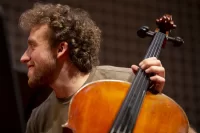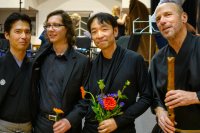
Performance closes Bates exhibition by major Chinese artist
The Bates College Museum of Art installation From Middle Kingdom to Biological Millennium, by Chinese artist Wenda Gu, closes with a reception and a performance piece by Gu at 7:30 p.m. Saturday, Oct. 9, in the Olin Arts Center, 75 Russell St.
Gu, one of the most important artists to emerge from China in recent decades, will perform Wenda Gu’s Wedding Life #6. The piece, says museum Director Mark Bessire, is an important new chapter in a series of performances, the most recent of which was held at the opening of the Guangzhou Triennial last year at the Guangdong Museum of Art, in China.
In a collaboration unusual for Maine’s academic museums, the Bates museum and the Institute of Contemporary Art at Maine College of Art, Portland, jointly presented Gu’s From Middle Kingdom this year. The museum installations and the performance piece reflect the artist’s belief that eventually the “biological millennium” will bring all races together into one mixed group, thus ending cultural conflict.
In Gu’s performances he symbolically weds a partner from another culture or ethnicity. Gu and his “bride,” performed by Sagaree Sengupta, of Lewiston, will arrive at the museum in a white limousine, welcomed by young people dressed in red. The couple will exchange wedding vows under the guidance of a justice of the peace, performed by Bessire.
Each participant will consider the creation of vows and then write the program together. Using huge ink brushes and sheets of paper spread on the floor, the bride and groom will write or draw important aspects of their life leading up to the marriage. After the vows are exchanged, they will draw together their aspirations for the future.
The performance will be presented around and under the Upper Gallery installation “united nations — 7561 kilometers.” The installation, 21st in a worldwide series, is a collection of hair from around the world brought together into a monument that symbolizes the unification of cultures, to be further intertwined through science and the “biological millennium.”
Meanwhile, showing in the Lower Gallery are New Acquisitions: Local and Global Contemporary Photography, which closes next May; and Marsden Hartley: Image and Identity, which closes Dec. 18 and is the focus of a museum symposium Nov. 5-6.
Gu was active in the Chinese avant-garde before emigrating to the United States in 1987. He mines tradition and pursues innovation in works that explore globalism, diasporic art and transculturalism to present an idealized unification of humanity.
“Wenda Gu’s work is timely in its ambitious attempt to address in artistic terms the issue of globalism that dominates discussions of contemporary economics, society and culture. The enormous scope of his vision — conceiving of his artwork as existing over time and space and not constrained by convention, language or national boundaries — is remarkable,” Bessire writes in the exhibition publication, the first major scholarly publication on Gu (MIT Press).
Bessire edited the publication and, with counterparts at museums in Kansas and Texas, co-curated the exhibition. The project was supported by The Andy Warhol Foundation for the Visual Arts and the National Endowment for the Arts.
Museum admission is open to the public at no cost. It is open 10 a.m.-5 p.m. Tuesday-Saturday and is closed Sundays and major holidays. For more information, call 207-786-6158.
A high-resolution image for publication of a 2000 performance of “Wendu Gu’s Wedding Life,” taken at the Utsunomiya Museum of Art, Japan, may be downloaded at this URL:
https://www.bates.edu/pix/Gu_Wedding.jpg




